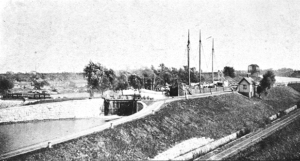The Bombing:
The Bombing:
The Bombing of Lock 24 on the Third Welland Canal
Mark Frampton
Port2Port - 2025
In 2023, the Welland Canal saw over twenty-seven million tonnes of cargo traverse its 43 km length.1 This slow winding waterway provides access to world markets for the abundant natural resources that begin their journey in the interior of Canada and the United States. Niagara residents routinely witness ships pass through the Welland Canal, but many are unaware of the violent events that have surrounded the canal throughout its history.
In the nearly 200-year history of the Welland Canal, it has been the target of at least three documented attempts to inflict damage upon it. Characters with such creative nicknames as "The Rob Roy of Upper Canada" or "Satan in a Top Hat" have attempted to deprive the people of Niagara of their beloved canal.2 On the evening of Saturday April 21, 1900, two American men, John Walsh and John Nolin, in conjunction with a third conspirator, J. Karl Dullman, put into motion a plan to destroy Lock 24 of the third Welland Canal in Thorold, Ontario. To put the location into context, lock 24 of the third Welland Canal would have lay just east of where lock 7 of the current Welland Ship Canal sits today; remnants of the third canal are still visible today.
Walsh and Nolin met in Philadelphia where they were paid a sum of $100, equal to about $3,700 CAD in today's currency, and given train tickets to Buffalo where they were to meet a third man, later identified as Karl Dullman.3 The men travelled from Buffalo and disembarked in Merritton (now a neighbourhood within St. Catharines).4 Walsh spent the afternoons of April 20 and 21, hiding satchels of dynamite near the canal in Thorold.5 Later in the evening on April 21, the men put their plan into motion. With one man standing at the north and south gates to the lock, they lowered satchels filled with dynamite down to the water. The gates to Lock 24 where the satchels of dynamite were placed can be seen in Figure 1.6 At 7:00 p.m. on the evening of the April 21, the residents of Thorold were startled by two explosions.

Figure 1: Lock 24, Third Welland Canal, in Thorold, Ontario.
Fortunately for the local residents, the plan was unsuccessful. The dynamite was placed near the hinges of the lock doors close to the water line, instead of near the opening. The water in the lock absorbed much of the concussive force of the explosion.7 Fortunately, Walsh and Nolin's miscalculation prevented disaster - had the bombing been successful, the lock would have released a wall of water down the escarpment nearly a half mile in length containing approximately 75,000 gallons. This deluge would have destroyed downstream portions of the canal, the adjacent Grand Trunk Railroad, the town of Merritton, and neighbourhoods beyond.8 The transport of industrial and commercial goods through the canal would have come to a halt and severely impacted the economics of the region.
News outlets across Canada and the United States theorised that the men were affiliated with the Boers of South Africa9 or disgruntled grain handlers from Buffalo, New York;10 this last theory did not, however, hold much water with local authorities.11 The perpetrators were determined to be affiliated with an Irish-American group called Clan-na-Gael; a successor to the Fenian Brotherhood.12 Their plan was a part of a long-standing vendetta against England and her former colonies.
The three men were sentenced at the Welland courthouse to serve life in prison at the Kingston Penitentiary. Two years later, Dullman was identified as Luke Dillon,13 the man accused of bombing the British House of Commons in 1885; he gained his freedom in 1914. Of Walsh and Nolin, one died in prison, and the other was released.14 The Bombing of Lock 24 on the Third Welland Canal was historically significant because not only did it target one of Canada's most vital industries, but it was one of the earliest examples of Fenian sabotage against British colonial authority. The attack revealed the vulnerability of early Canadian infrastructure, prompting reassessments on the protection of canals and bridges, leading to stricter supervision of explosives.
-
The St. Lawrence Seaway Management Corporation and Great Lakes St. Lawrence Seaway Development Corporation, The St. Lawrence Seaway, The St. Lawrence Seaway Management Corporation (2023). ↩
-
Alun Hughes, "Terrorist Attacks on the Welland Canal," Newsletter, Historical Society of St. Catharines (2008). ↩
-
Author Unknown, "Thorold Explosion was a Fenian Plot," The Argus, May 18, 1900. ↩
-
Hughes, "Terrorist Attacks," 7. ↩
-
Author Unknown, "Thorold Explosion," ↩
-
Figure 1: [Lock 24, Third Welland Canal, in Thorold, Ontario], photograph, The Daily British Whig, no. 74 (1902). ↩
-
Author Unknown, Dynamite Dillon, Scottish Military Disasters, n.d. ↩
-
Author Unknown, "Attempt to blow up the canal," Marine news 5 no.1 (2002), 66. ↩
-
Author Unknown, "Dynamiters at Work," The Wingham Times, Apr. 23, 1900. ↩
-
Author Unknown, "Welland Canal Badly Damaged," Buffalo Evening News 40, no. 11 (1900), 1. ↩
-
Author Unknown, "Welland Dynamiters Silent," Buffalo Evening News 40 no. 12 (1900), 1. ↩
-
Author Unknown, "Thorold Explosion." ↩
-
Author Unknown, "Say he is Like Dylan," The British Whig no. 74 (1902). ↩
-
Hughes, "Terrorist Attacks," 8. ↩

